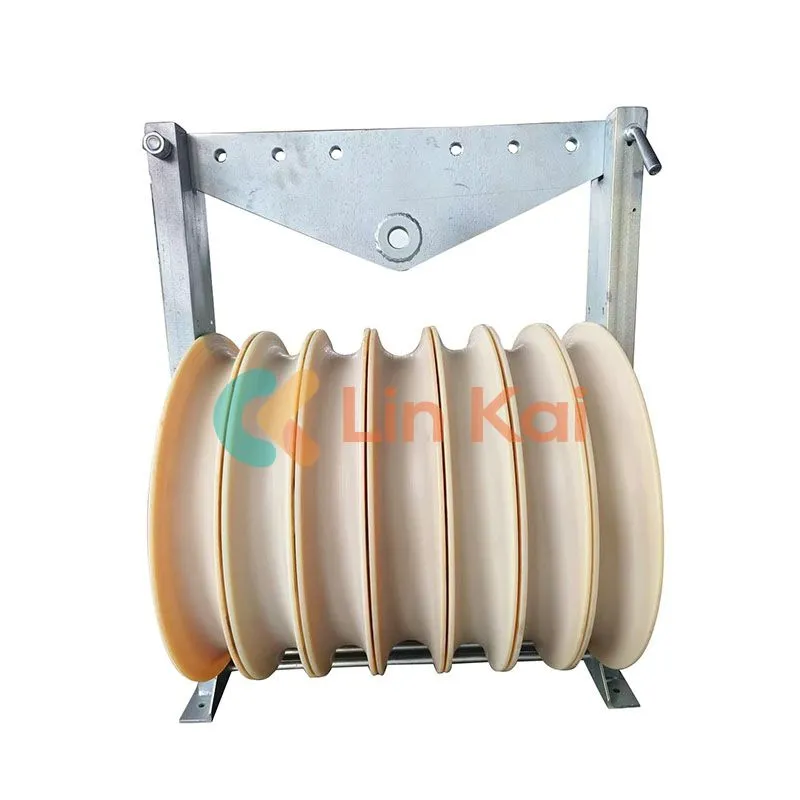
- English
- Español
- Português
- русский
- Français
- 日本語
- Deutsch
- tiếng Việt
- Italiano
- Nederlands
- ภาษาไทย
- Polski
- 한국어
- Svenska
- magyar
- Malay
- বাংলা ভাষার
- Dansk
- Suomi
- हिन्दी
- Pilipino
- Türkçe
- Gaeilge
- العربية
- Indonesia
- Norsk
- تمل
- český
- ελληνικά
- український
- Javanese
- فارسی
- தமிழ்
- తెలుగు
- नेपाली
- Burmese
- български
- ລາວ
- Latine
- Қазақша
- Euskal
- Azərbaycan
- Slovenský jazyk
- Македонски
- Lietuvos
- Eesti Keel
- Română
- Slovenski
- मराठी
- Srpski језик
Why Are Stringing Blocks Important?
2024-09-13
Power line construction is a complex and highly technical process that requires precision, safety, and the use of specialized equipment. One of the most crucial tools in this process is the stringing block. These devices are instrumental in ensuring the efficient installation of power lines, and they play a key role in protecting the integrity of the conductors during the construction phase. In this blog, we'll explore the importance of stringing blocks and why they are vital for the successful completion of power line projects.
What Are Stringing Blocks?

Stringing blocks, also known as conductor blocks or pulleys, are wheel-like devices used in power line construction to guide and support electrical conductors as they are pulled through transmission towers. They are typically made from materials like aluminum or nylon and are designed to minimize friction and prevent damage to the cables as they are installed. These blocks come in various sizes and configurations, depending on the specific needs of the construction project.
Why Are Stringing Blocks Important?
1. Minimizing Friction and Cable Damage
During power line installation, electrical conductors are often pulled over long distances and through various structures, such as transmission towers. Without stringing blocks, the friction generated between the conductor and the supporting structures would be significant, leading to potential wear, damage, or breakage of the cables. Stringing blocks are designed to reduce this friction, allowing for smooth and controlled cable movement. This not only protects the integrity of the conductor but also extends its lifespan by preventing premature wear and tear.
2. Ensuring Proper Tensioning
One of the biggest challenges in power line construction is maintaining the correct tension in the conductors. Incorrect tensioning can lead to a variety of problems, including sagging lines, which can pose safety risks and affect the performance of the power system. Stringing blocks play a critical role in ensuring that the conductors are pulled with the proper tension, reducing the risk of conductor sagging or snapping during installation.
3. Improving Safety
Power line construction is a hazardous activity, with crews often working at great heights and handling heavy, high-tension cables. Stringing blocks improve safety by allowing for more controlled and precise handling of these cables. By minimizing the risk of conductor damage or accidental snapping, stringing blocks help to prevent potentially dangerous situations on the job site. They also reduce the physical strain on workers by making it easier to maneuver the cables through the towers.
4. Enabling Efficient Installation Over Long Distances
Stringing blocks are especially important for projects that require the installation of power lines over long distances or challenging terrain. In such cases, the conductors need to be pulled across uneven ground, rivers, valleys, or mountains, which can create additional stress on the cables. Stringing blocks help to distribute the weight and tension evenly, allowing for a smoother and more efficient installation process, regardless of the geographical challenges involved.
5. Reducing Maintenance and Repair Costs
By ensuring the proper installation of conductors and preventing damage during the construction phase, stringing blocks help to reduce the likelihood of maintenance issues down the line. Properly installed conductors are less likely to experience faults, sagging, or breakage, which translates into fewer repairs and lower maintenance costs over the lifespan of the power line. This makes stringing blocks not only an important tool for construction but also a cost-saving investment in the long-term reliability of the power system.
Types of Stringing Blocks
Stringing blocks come in a variety of designs, each suited to different aspects of power line construction:
- Single Sheave Blocks: These are the most common type and are used for guiding a single conductor during installation.
- Multiple Sheave Blocks: These blocks are used when pulling multiple conductors simultaneously, which is common in larger transmission projects.
- Helicopter Stringing Blocks: Designed for use in helicopter-assisted installations, these blocks allow conductors to be pulled from the air, making them ideal for difficult-to-reach locations.
- Angle Stringing Blocks: These blocks are designed for installation projects that require pulling conductors around sharp corners or curves, ensuring smooth operation without excessive tension or friction.
Conclusion
Stringing blocks are an indispensable tool in power line construction, ensuring the safe, efficient, and reliable installation of electrical conductors. By minimizing friction, maintaining proper tension, and improving overall safety, they play a crucial role in protecting the integrity of power lines and reducing maintenance costs in the long run. Whether installing power lines over flat terrain or through challenging landscapes, stringing blocks make the process more manageable and safer for workers.
In an industry where reliability and safety are paramount, investing in high-quality stringing blocks is a smart decision that ensures power lines are installed correctly, efficiently, and with minimal risk.
Ningbo Lingkai Overhead Line Transmission Tools Manufacture has more than 20 years, engaged in the Conductor Pulley Stringing Blocks supplier, and it is only one of the top terminal plants, well known in China.
Visit our website at https://www.lkstringing.com to learn more about our products. For inquiries, you can reach us at btransmission@163.com.
How does overhead line stringing equipment support the development of modern power grids?
What is Bundle Conductor Stringing Blocks and How Does it Work?
What safety features do Aerial Conductor Stringing Blocks have?



